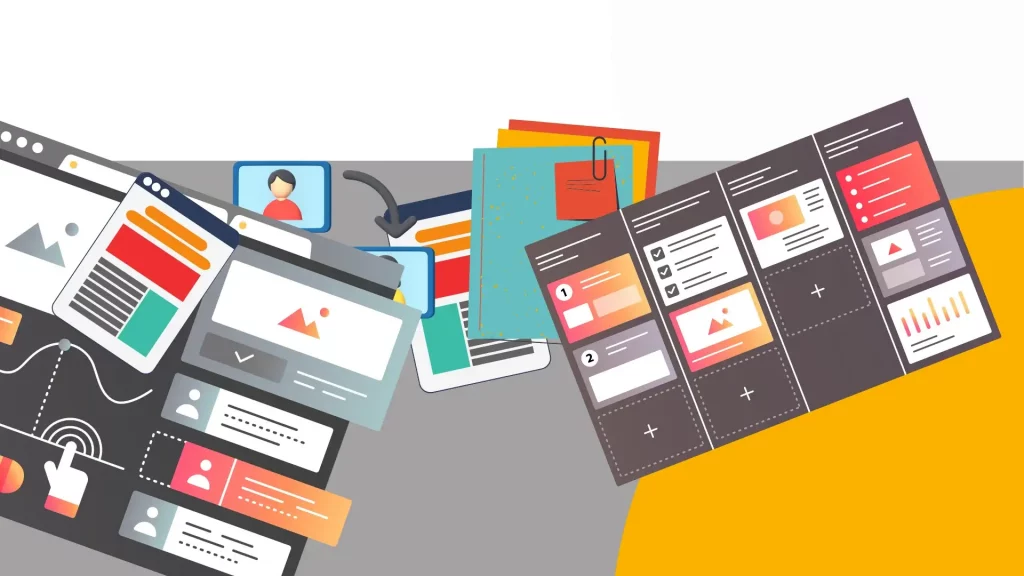Are you looking to enhance your employee training programs? Do you want to create engaging and effective training materials that truly help your employees grow? Look no further! In this blog, we will provide you with how to create training materials, a comprehensive 5-step guide that deliver results. From understanding what training materials are and why they are important, to making them attractive to learners and defining clear learning objectives, we’ve got you covered.
We’ll also share examples of effective training materials, such as online courses, quizzes, and training videos. Plus, we’ll discuss different methods for creating how to create training materials, including manuals, templates, infographics, and visual aids. And finally, we’ll show you how to measure the effectiveness of your training materials. Get ready to take your employee training to the next level!
What are training materials?
Training materials are educational resources that aid in learning and development during a training program. They encompass a wide range of resources like presentations, handouts, manuals, videos, online modules, and interactive activities. How to create training materials is simple – It is designed to enhance the learning experience and provide valuable information to participants.Training That Helps Employees Grow
Training materials are essential for employee training and development. They are designed to provide employees with the necessary knowledge and skills to excel in their job roles. By using a variety of training content, such as webinars, case studies, and simulations, training materials cater to different learning styles and preferences. They help employees how to create training materials which in turn, acquire new skills, stay updated with industry trends, and improve their overall performance. With well-designed training materials, organizations can ensure that their employees have the tools they need to grow and succeed in their roles.The importance of training materials
Training materials hold immense importance in any learning and development process. How to create training materials provide a structured and organized approach, ensuring consistency in the delivery of information and skills. Whether it’s for initial training or ongoing development, training materials play a pivotal role in equipping employees with the necessary knowledge and tools for success. They enable learners to understand and retain information effectively. By incorporating various formats such as manuals, templates, infographics, and training videos, training materials create an engaging learning experience. Moreover, how to create training materials cater to different types of training, from compliance training to enhancing technical skills. With their comprehensive content and diverse delivery methods, training materials contribute significantly to employee growth and engagement.How to make instructional materials attractive to the learners?
To make instructional materials attractive to learners on how to create training materials, utilize visually appealing design elements like colors, fonts, and graphics. Break down information into smaller, easily digestible sections with headings, subheadings, and bullet points. Incorporate multimedia elements such as images, videos, and interactive quizzes to enhance engagement. Also, include real-life examples and practical exercises on how to create training materials to make the content more relatable and engaging for learners.How to define learning objectives?
When looking at how to create training materials, it is important to define clear and concise learning objectives that align with your overall goals. To do this, start by understanding how to create training materials with the specific knowledge or skills you want your learners to acquire. Break these objectives down into measurable and actionable statements using action verbs. Consider the background knowledge of your target audience to ensure the objectives are tailored to their needs. It is also crucial to align your objectives with the desired outcomes of how to create training materials and the goals of your organization. By defining learning objectives effectively, you can create focused and effective training materials that drive learner engagement and success.Assessing existing training material
Assessing on how to create training materials is crucial when it comes to creating high-quality training materials. It serves as a foundational step in the development process. Before diving in, it is important to establish clear learning objectives that will shape on how to create training materials. By carefully examining the current training material, you can gain valuable insights into what has already been covered and identify any potential gaps that need to be addressed. This assessment allows you to identify outdated information, unclear explanations, or missing content. By doing so, you can customize the new training materials to meet the specific needs of the learners and provide an engaging and tailored learning experience.Developing training materials
Developing effective training materials involves identifying the target audience, how to create training materials, defining learning objectives, and creating well-structured content. Start by considering factors such as learner background, experience, and preferred learning styles. Tailor the content to meet their needs. Clearly define learning objectives and use concise language, visuals, and examples to enhance understanding. Organize the information logically. Review and revise the materials, gathering feedback from colleagues or experts to improve quality. This iterative process ensures the creation of high-quality training materials.Types of training materials
In the realm of how to create training materials, there is a myriad of options to explore. Among them, online courses stand tall as an innovative way to facilitate learning among your workforce. They can be a medium to how to create training materials. Their key advantage lies in the convenience they offer, empowering learners to progress at their own pace and access materials at their convenience. Taking a different route, interactive quizzes can prove highly engaging, providing an opportunity to test knowledge while fostering active participation. Additionally, training videos are a powerful tool, enabling real-life scenarios to be demonstrated, appealing to visual and auditory learners alike that could contribute in how to create training materials. By leveraging these diverse resources, you can curate a well-rounded, highly effective training program that accelerates employee growth.Online courses
Developing on how to create training materials can be made easier with the use of online courses held by team members. These courses provide a flexible learning experience for employees, enabling them to access the material at their convenience. By utilizing interactive elements such as quizzes, videos, and discussion forums, online courses make the learning process engaging and dynamic. Whether it’s using a learning management system or an e-learning platform, these courses simplify the distribution and management of training materials. By incorporating online courses into your training program, you can provide comprehensive content that allows employees to learn how to create training materials at their own pace and develop new skills.Quizzes
Engaging quizzes play a vital role on how to create training materials, offering learners an opportunity to actively participate and evaluate their understanding. By integrating multiple-choice and fill-in-the-blank quizzes into the training program, you can assess knowledge, reinforce information, and encourage learners to recall essential details. With quizzes, you create an interactive learning experience that captivates learners and provides valuable feedback on their progress. These evaluation tools enhance the effectiveness of your training content, making it an effective method for creating engaging and productive learning experiences for your employees.Training videos
Videos are a great way to deliver training materials to learners without any hassles. They provide visual demonstrations, explanations, and step-by-step instructions, making the learning process more interactive and engaging. Training videos can be used for a variety of purposes, such as onboarding new employees, teaching specific skills, or even compliance training. They offer an effective way to communicate complex concepts and ensure better understanding among trainees. With the flexibility to pause, rewind, and revisit the videos, employees can learn at their own pace, enhancing their overall learning experience. By incorporating training videos into training programs, organizations can create effective training materials that help in employee development process without any hassle.Training Material Development
Developing effective training materials is crucial for the success of any training program. To create high-quality training materials, you need to follow a systematic approach that ensures the content is tailored to meet the needs of your learners. The first step is to determine on how to create training materials is to delve on the objectives and goals of your training program. By clearly defining what you want your learners to achieve, you can design the content and structure of your training materials, including lesson plans, presentations, and handouts, in a way that aligns with these objectives. The next step is to conduct a needs assessment to identify the knowledge and skills gaps among your learners. This process involves gathering information about the current state of your employees’ skills and competencies, as well as their training needs. By conducting a thorough needs assessment, you can gain valuable insights into what areas you need to focus on in your training materials. Once you have identified the gaps, you can start designing engaging and interactive activities to enhance the learning experience. This can include using different formats such as quizzes, online courses, webinars, and training videos. By incorporating a variety of activities, you can cater to different learning styles and keep your learners engaged throughout the training process. It is also important to consider the use of infographics, graphics, and other visual aids to help reinforce key information and make the training materials more visually appealing.Creating engaging training materials for employee engagement
Engaging employees in the learning process is essential for the success of any training course. When creating training materials, it is important to consider the needs and preferences of your learners. By breaking down the content into manageable modules, you can make it easier for employees to digest the information and retain knowledge. Incorporating various media and interactive elements, such as infographics and visuals, can enhance the learning experience and keep employees engaged. Additionally, utilizing different formats, like videos or quizzes, can provide a well-rounded learning experience. By following these guidelines, you can create engaging training materials that effectively support employee development.Training Manual and templates
Creating training materials involves utilizing manuals and templates, which play a crucial role in creating a training plan which helps in organizing content and providing learners with clear instructions. This enables them to effectively navigate the training material and achieve their learning objectives. Manuals offer step-by-step guidance, while templates provide a structured framework for consistency. By tailoring these resources to suit the requirements of the target audience, trainers can enhance the overall learning experience. By integrating manuals and templates into the training development process, trainers can create effective and engaging materials that cater to the specific needs of learners.Infographics and visual aids
Infographics and visual aids play a significant role in creating engaging training materials. These powerful tools present information in visually appealing ways, allowing learners to understand complex concepts quickly. By incorporating infographics and visual aids like charts, graphs, diagrams and illustrations, training materials become more interactive and interesting. Learners find it easier to comprehend the content when presented in smaller, digestible chunks. Including these elements in your training materials enhances the learning experience and boosts information retention. Infographics and visual aids are the best way to make your training materials more effective and memorable, benefiting both the trainer and the trainees.Measuring the checklist for the effectiveness of training materials
Evaluating the impact of training materials is essential to assess their effectiveness and alignment with learning objectives. A thorough evaluation is vital for measuring the success of a training program and identifying areas for enhancement. Understanding how to create training materials and evaluating their impact is the first step. It’s important to identify learning objectives and desired outcomes clearly. Testing the materials with a sample group in various formats such as online courses, quizzes, or training videos can provide valuable feedback to enhance their efficacy. Continuous assessment and gathering participant feedback are vital for gauging the effectiveness of the materials. By ensuring these aspects in the development process, organizations can create engaging and effective training materials that drive learner engagement and improve employee performance.Conclusion
In conclusion, creating effective training materials is crucial for the growth and development of your employees. By following a step-by-step guide and incorporating engaging elements such as online courses, quizzes, and training videos, you can ensure that your training materials are attractive to learners and facilitate effective learning. Don’t forget to measure the effectiveness of your training materials through evaluation and adjustments as needed. To learn more about how to create impactful training materials, check out our comprehensive blog with examples and practical tips. Start investing in the growth of your employees today!Ace performance reviews with strong feedback skills.
Master the art of constructive feedback by reviewing your skills with a free assessment now.
Frequently Asked Questions
What are the four sources of training material?
The four sources of training material include internal documents and resources, industry-specific books and publications, online resources like webinars and video tutorials, and subject matter experts from within the organization or external consultants. These sources provide a variety of knowledge and expertise to support effective training.
How do you create training materials?
To create training materials, begin by clarifying the learning objectives and goals. Collect and arrange appropriate content like text, images, videos, and interactive elements. Organize the materials logically with headings, subheadings, and bullet points. Add engaging elements such as quizzes, case studies, role plays, and hands-on activities for effective learning.
Are the training materials engaging and didactic?
The training materials should be captivating to grab the learners’ attention and keep them interested. They should effectively convey information and facilitate learning. Incorporate engaging multimedia elements like videos and interactive activities, along with clear objectives, relevant examples, and practical exercises to make the training materials both engaging and didactic.






